
As the sheer amount of digital surface continues to grow, advertisers, marketers and endusers are seeking new approaches in order to stand out in an increasingly busy electronic landscape. Likewise, designers are eager for new mediums of creativity that offer imaginative ways to present digital content and engage audiences.
A new option that is available includes transparent OLED (organic light emitting diode) displays—an innovation in digital signage where dynamic content is transmitted onto a transparent surface, allowing people to view what is shown on the display while still being able to see through it. This allows designers to overlay digital images and video content onto physical objects or scenes placed behind the glass. A transparent OLED display eliminates the need for a backlight or enclosure, making it possible to create truly see-through installations in a virtually frameless glass design.
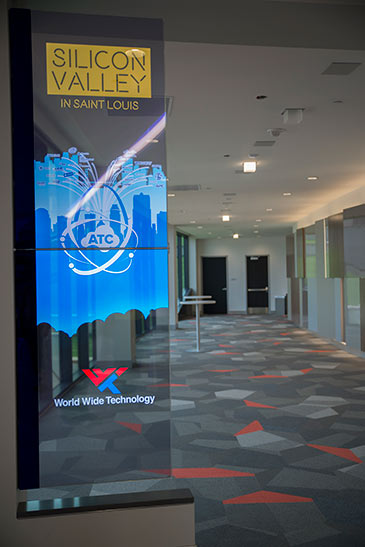 Transparent OLED displays eliminate the need for a backlight or enclosure. Users can view content on the glass display and are also able to see through it.
Transparent OLED displays eliminate the need for a backlight or enclosure. Users can view content on the glass display and are also able to see through it.How does transparent OLED technology work?
OLEDs are used in mobile devices, televisions and lighting fixtures, and offer high-quality imagery and vivid colors. The technology that generates transparent OLED displays features self-lighting pixels that are partially clear. Each pixel is made up of four sub-pixels. Three of them are red, green and blue, which, when combined, create color. The remaining sub-pixel is clear, which drives the transparency.
Transparent OLED technology is based on a direct relationship between resolution and transparency. If a transparent OLED display contains a higher portion of active (color) pixels, less space will be available for clear pixels, resulting in a display that is less see-through. Full HD resolution represents an advantage with transparent OLED displays as both transmission and resolution are optimized. Black or dark content in a transparent OLED display is clear while white or bright content is opaque.
Just like any glass surface, the amount of ambient light affects the perceived transparency of a transparent OLED display. In other words, the greater the illumination, the more transparent the screen becomes. As an example, a transparent display in a dark room will appear opaque, but in a bright room with objects or scenes behind the display heavily lit, the display will appear like transparent glass.
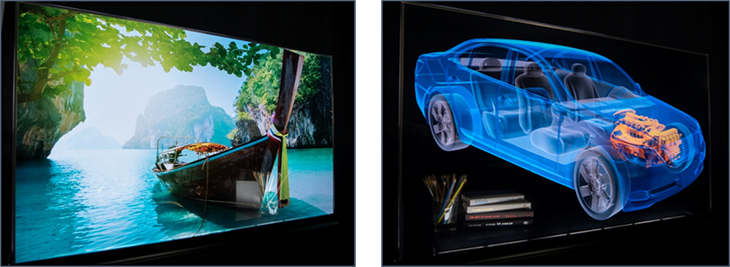 (Left) White or bright content will be opaque and shine from the screen and appear in the foreground. (Right) Black or dark (or off-state) content will be see-through.
(Left) White or bright content will be opaque and shine from the screen and appear in the foreground. (Right) Black or dark (or off-state) content will be see-through.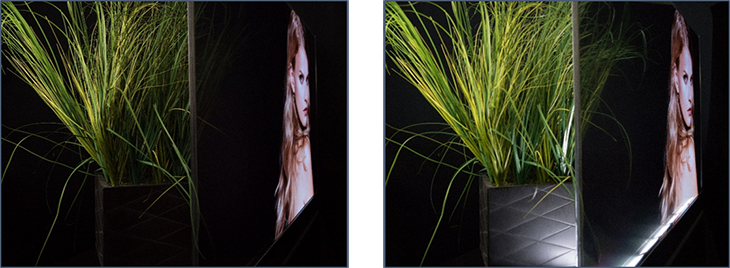 (Left) No uplight. Display looks more opaque. (Right) Plant is uplit. Display looks more transparent.
(Left) No uplight. Display looks more opaque. (Right) Plant is uplit. Display looks more transparent.Broad color gamut of OLED makes content appear brighter
OLED technology is recognized for its robust color performance. Compared to best-in-class LCD displays which achieve around 72% NTSC dolor space (a measure of the number of colors the display is cable of showing), OLED can achieve greater than 100%. This translates to brilliant reds, vibrant greens and vivid blues. The color performance of OLED technology combined with the peak brightness characteristics of the emissive display generates imagery that appears to be much brighter than what it actually is. That’s because the human eye translates color as brightness. In a side-by-side comparison with a “brighter” display, the transparent OLED display will look more vivid.
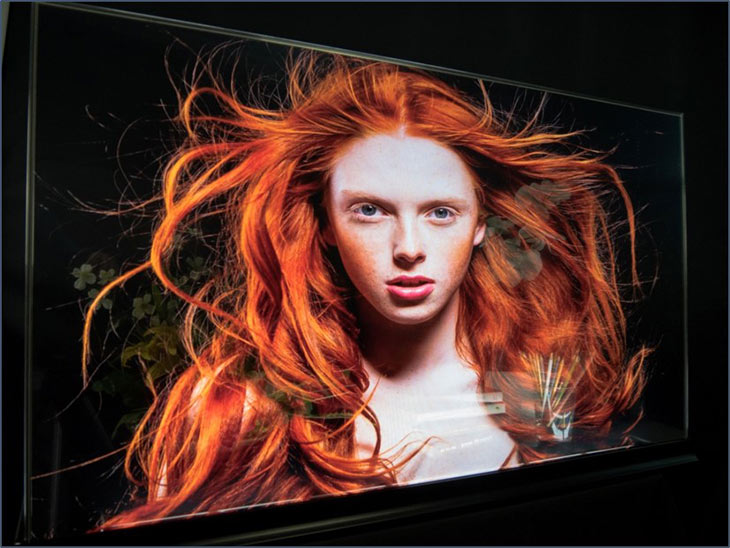 Greater than 100% NTSC
Greater than 100% NTSCLifetime considerations
The content selection for a transparent OLED display is an important consideration that directly affects image performance, power usage and product lifetime. With OLED technology, black pixels are at rest (low power, longer life) and blue color represents the highest energy use (and blue ages faster than other primaries). Therefore, it follows that the more pixels are at rest (by using black content), the less power will be used and the longer those pixels will last—ensuring the display remains transparent for a longer time.
Lifetime is related to hours of life for each pixel, so it is recommended that agencies, content developers and endusers keep content mostly black, ensure that the content is active and moving, and avoid content that is static so as not to damage the display with image retention.
What is possible with transparent OLED displays?
Since transparent OLED is quite clear, the fine details—such as text on objects—are easily legible behind the display. The ample clarity allows retail merchandisers and museum exhibit designers to place transparent OLED displays in front of products or artifacts without obscuring the view. In fact, the visibility through a transparent OLED display is a clear enough to see objects in the background distance. A person with 20/20 vision could look through such a display and easily read a sign over 30 feet away.
Viewers who look through the display from the back side will see content in reverse and observe that the brightness and contrast are lower. Objects or scenes located on the back side of the display become reflected on the screen when looking through the display from the reverse side. However, the reflected objects or scenes do not fully obscure content or the view through the display. As such, with a nearly 360-degree viewing angle possible, new opportunities in two-way display applications are possible.
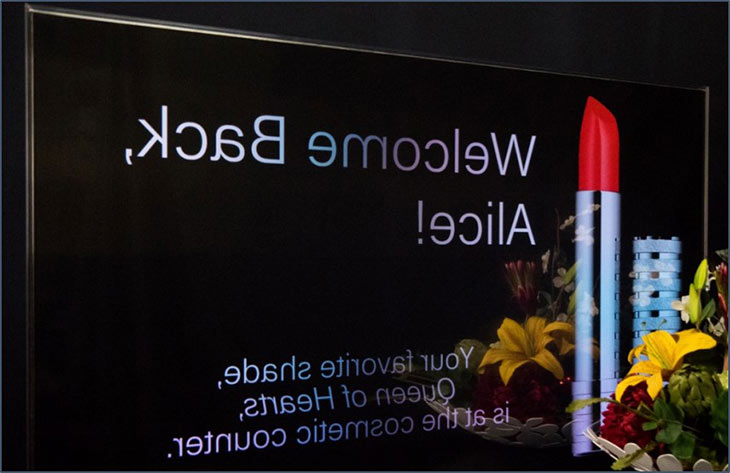 The view through a transparent OLED display from the back side reveals that content is reversed, and brightness and contrast are lower. Objects or scenes placed on the back side of the display are reflected on the screen but do not fully obscure content or the view through the display.
The view through a transparent OLED display from the back side reveals that content is reversed, and brightness and contrast are lower. Objects or scenes placed on the back side of the display are reflected on the screen but do not fully obscure content or the view through the display.A new world of design possibilities
With striking new creations possible that previously were only seen in science fiction movies, transparent OLED displays allow designers to expand their imaginations—and extend their ideas beyond the digital canvas. For example, when another electronic display is placed behind a transparent OLED display, a unique 3D layered effect is created, offering a wide range of exciting potential. Transparent OLED displays enable never-before-possible applications in digital signage that can be integrated into any environment where glass is used, such as room dividers, glass conference rooms, storefront windows, glass counters, museum exhibits, or ticket booths.
When specifying a transparent OLED display, the limitations of the technology are just as important to consider as the benefits. The best performance will be achieved when content developers, artists and programmers work closely with integrators to ensure that content utilizes high amounts of black in every frame (for maximum transparency and lifetime), is highly dynamic (no static logos or words), and makes use of ambient or spot lighting that can be orchestrated with screen content to create the most interesting effects.
With thoughtful design, transparent OLED displays offer limitless potential to modernize interiors with impactful color, striking graphics and text, and a wow-effect that can draw customers to engage. Whether used in stand-alone configurations or integrated into larger video wall arrays, the possibilities are boundless.
Planar LookThru Transparent OLED Displays
In 2015, Planar became the first to demonstrate and market a transparent OLED display line of products. The Planar® LookThru™ Transparent OLED Display allows both portrait and landscape modes and can be table-mounted, ceiling-mounted or built into custom fixtures using a straight flush-mount design. Available in a 55-inch display, the Planar LookThru offers vibrant colors at 120 percent NTSC performance and includes wide viewing angles with no off-axis contrast or brightness limitations. Full HD resolution delivers beautiful graphics and full-motion video.
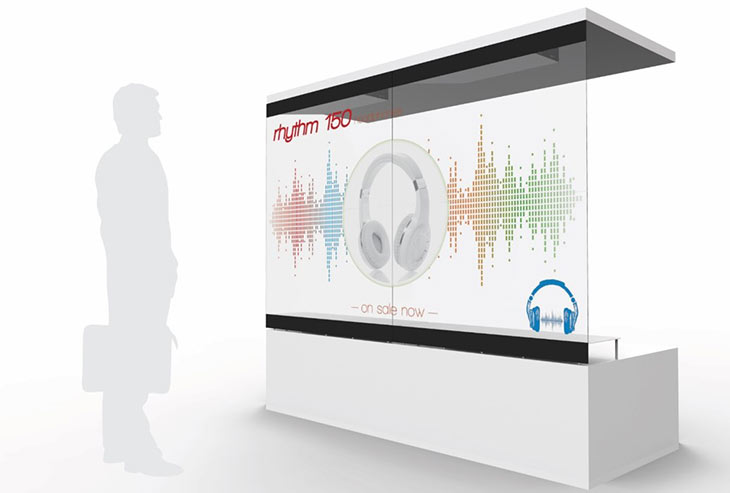 The Planar LookThru Transparent OLED Display features 6mm bezels on the top, right and left edges of the display, allowing for tiling.
The Planar LookThru Transparent OLED Display features 6mm bezels on the top, right and left edges of the display, allowing for tiling.The design flexibility and thin edges of the Planar LookThru enable tiling to create video arrays that meet the requirements for larger applications. The displays feature small bezels of only 6mm on the top, right and left edges for a nearly seamless solution.
To facilitate tiling, a range of accessories are available including four tiling components that protect display intersections as well as base plates for securing the displays to ceilings, tables and walls. To achieve the full experience, the video wall should be accompanied by a multi-channel video processor which can play back one video or content selection across multiple monitors assembled into a video wall.
The Planar LookThru utilizes proprietary Planar® ERO-OLED™ (Extended Ruggedness and Optics) technology featuring Corning Gorilla Glass. This high-durability surface can withstand the rigors of high-traffic environments. It also improves perceived contrast by more than 300 percent, making the display more readable and impactful even in bright public venues.


